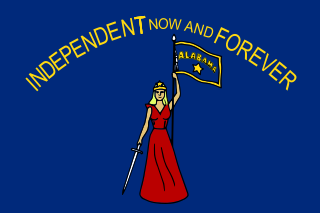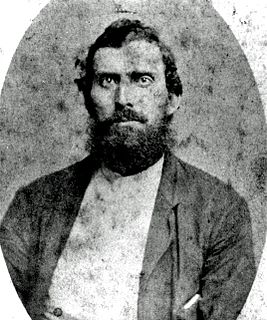Related Research Articles

The Confederate States of America (CSA), commonly referred to as the Confederate States or simply the Confederacy, was an unrecognized breakaway republic in North America that existed from February 8, 1861, to May 9, 1865. The Confederacy comprised U.S. states that declared secession and warred against the United States during the American Civil War. Eleven U.S. states, nicknamed Dixie, declared secession and formed the main part of the CSA. They were South Carolina, Mississippi, Florida, Alabama, Georgia, Louisiana, Texas, Virginia, Arkansas, Tennessee, and North Carolina. Kentucky and Missouri also had declarations of secession and full representation in the Confederate Congress during their Union army occupation.

In the context of the American Civil War (1861–65), the border states were slave states that did not secede from the Union. They were Delaware, Maryland, Kentucky, and Missouri, and after 1863, the new state of West Virginia. To their north they bordered free states of the Union and to their south they bordered slave states of the Confederacy, with Delaware being an exception to the latter.

The Constitutional Union Party was a United States third party active during the 1860 elections. It consisted of conservative former Whigs, largely from the Southern United States, who wanted to avoid secession over the slavery issue and refused to join either the Republican Party or the Democratic Party. The Constitutional Union Party campaigned on a simple platform "to recognize no political principle other than the Constitution of the country, the Union of the states, and the Enforcement of the Laws".
In American history, the Fire-Eaters were a group of pro-slavery Democrats in the Antebellum South who urged the separation of Southern states into a new nation, which became the Confederate States of America. The dean of the group was Robert Rhett of South Carolina. Some sought to revive America's participation in the Atlantic slave trade, which had been illegal since 1808.

William Lowndes Yancey was an American journalist, politician, orator, diplomat and an American leader of the Southern secession movement. A member of the group known as the Fire-Eaters, Yancey was one of the most-effective agitators for secession and rhetorical defenders of slavery. An early critic of John C. Calhoun at the time of the Nullification Crisis of 1832–33, Yancey began to identify with Calhoun and the struggle against the forces of the anti-slavery movement by the late 1830s. In 1849, Yancey was a firm supporter of Calhoun's "Southern Address" and an adamant opponent of the Compromise of 1850.

Edmund Ruffin III was a wealthy Virginia planter who served in the Virginia Senate from 1823 to 1827. In the last three decades before the American Civil War, his pro-slavery writings received more attention than his agricultural work. Ruffin, a slaveholder, staunchly advocated states' rights and slavery, arguing for secession years before the Civil War, and became a political activist with the so-called Fire-Eaters. Ruffin is given credit for "firing the first shot of the war" at the Battle of Fort Sumter in April 1861 and fought as a Confederate soldier despite his advanced age. When the war ended in Southern defeat in 1865, he committed suicide rather than submit to "Yankee rule."

An Ordinance of Secession was the name given to multiple resolutions drafted and ratified in 1860 and 1861, at or near the beginning of the Civil War, by which each seceding Southern state or territory formally declared secession from the United States of America. South Carolina, Mississippi, Georgia, and Texas also issued separate documents purporting to justify secession.

The Peace Conference of 1861 was a meeting of 131 leading American politicians in February 1861, at the Willard's Hotel in Washington, D.C., on the eve of the American Civil War. The purpose of the conference was to avoid, if possible, the secession of the eight slave states, from the upper and border South, that had not done so as of that date. The seven states that had already seceded did not attend.
The Unionist Party, later known as the Unconditional Union Party in the border states, was a political party in the United States started after the Compromise of 1850 to define politicians who supported the Compromise. It was used primarily as a label by politicians who did not want to affiliate with the Republicans, or wished to win over anti-secession Democrats. Members included Southern Democrats who were loyal to the Union as well as elements of the old Whig Party and other factions opposed to a separate Southern Confederacy.

Alabama was central to the Civil War, with the secession convention at Montgomery, birthplace of the Confederacy, inviting other states to form a Southern Republic, during January–March 1861, and develop constitutions to legally run their own affairs. The 1861 Alabama Constitution granted citizenship to current U.S. residents, but prohibited import duties (tariffs) on foreign goods, limited a standing military, and as a final issue, opposed emancipation by any nation, but urged protection of African slaves, with trial by jury, and reserved the power to regulate or prohibit the African slave trade. The secession convention invited all slaveholding states to secede, but only 7 Cotton States of the Lower South formed the Confederacy with Alabama, while the majority of slave states were in the Union. Congress voted to protect the institution of slavery by passing the Corwin Amendment on March 4, 1861, but it was never ratified.

The American Civil War made a huge impact on Tennessee, with large armies constantly destroying its rich farmland, and every county witnessing combat. It was a divided state, with the Eastern counties harboring pro-Union sentiment throughout the conflict, and it was the last state to officially secede from the Union, in protest of President Lincoln's April 15 Proclamation calling forth 75,000 members of state militias to suppress the rebellion. Although Tennessee provided a large number of troops for the Confederacy, it would also provide more soldiers for the Union Army than any other state within the Confederacy.

Texas declared its secession from the Union on February 1, 1861, and joined the Confederate States on March 2, 1861, after it had replaced its governor, Sam Houston, who had refused to take an oath of allegiance to the Confederacy. As with those of other states, the Declaration of Secession was not recognized by the US government at Washington, DC. Some Texan military units fought in the Civil War east of the Mississippi River, but Texas was more useful for supplying soldiers and horses for the Confederate Army. Texas' supply role lasted until mid-1863, when Union gunboats started to control the Mississippi River, which prevented large transfers of men, horses, or cattle. Some cotton was sold in Mexico, but most of the crop became useless because of the Union's naval blockade of Galveston, Houston, and other ports.

The American state of Virginia became a prominent part of the Confederacy when it joined during the American Civil War. As a Southern slave-holding state, Virginia held the state convention to deal with the secession crisis, and voted against secession on April 4, 1861. Opinion shifted after the Battle of Fort Sumter on April 12, and April 15, when U.S. President Abraham Lincoln called for troops from all states still in the Union to put down the rebellion. For all practical purposes, Virginia joined the Confederacy on April 17, though secession was not officially ratified until May 23. A Unionist government was established in Wheeling and the new state of West Virginia was created by an act of Congress from 50 counties of western Virginia, making it the only state to lose territory as a consequence of the war.

Louisiana was a dominant population center in the southwest of the Confederate States of America, controlling the wealthy trade center of New Orleans, and contributing the French Creole and Cajun populations to the demographic composition of a predominantly Anglo-American country. In the antebellum period, Louisiana was a slave state, where enslaved African Americans had comprised the majority of the population during the eighteenth-century French and Spanish dominations. By the time the United States acquired the territory (1803) and Louisiana became a state (1812), the institution of slavery was entrenched. By 1860, 47% of the state's population were enslaved, though the state also had one of the largest free black populations in the United States. Much of the white population, particularly in the cities, supported slavery, while pockets of support for the U.S. and its government existed in the more rural areas.

In the United States, Southern Unionists were white Southerners living in the Confederate States of America opposed to secession. Many fought for the Union during the Civil War. These people are also referred to as Southern Loyalists, Union Loyalists, or Lincoln's Loyalists. Pro-Confederates in the South derided them as "Tories". During Reconstruction, these terms were replaced by “scalawag”, which covered all Southern whites who supported the Republican Party.

Benjamin Lewis Hodge was a Confederate politician who commanded the 19th Louisiana Infantry Regiment during the early stages of the American Civil War, including during the Battle of Shiloh.
The U.S. state of Louisiana declared that it had seceded from the United States on January 26, 1861. It then announced that it had joined the Confederate States (C.S.); Louisiana was the sixth slave state to declare that it had seceded from the U.S. and joined the C.S.

The Virginia Secession Convention of 1861 was called in Richmond to determine whether Virginia would secede from the United States, to govern the state during a state of emergency, and to write a new Constitution for Virginia, which was subsequently voted down in referendum under the Confederate Government.

The 1861 Maryland gubernatorial election took place on November 6, 1861. It was held amid the early phases of the American Civil War and was contested between the Unionist Party's Augustus Bradford and the Democratic Party's Benjamin Chew Howard. Bradford supported the maintenance of the Union while Howard advocated for a peace treaty with the Confederacy. Concerned about pro-secession elements in the state, the federal government sent troops to supervise the vote and ordered electors to take an oath of loyalty to the Union. The election was won by Bradford with 68.8% of the votes.
References
- ↑ Ayers, Edward L. In the Presence of Mine Enemies: The Civil War in the Heart of America, 1859-1863. New York: Norton, 2003. Print.
- ↑ Sacher, John M. (2007). A Perfect War of Politics: Parties, Politicians, and Democracy in Louisiana, 1824-1861. LSU Press. p. 292. ISBN 978-0-8071-3242-5.
- ↑ Journal and proceedings of the Missouri state convention: held at Jefferson City and St. Louis, March, 1861. G. Knapp. 1861. pp. 146.
- ↑ Ruffin, Edmund (1977). Diary of Edmund Ruffin: The Years of Hope: April, 1861-June, 1863. LSU Press. p. 121. ISBN 978-0-8071-0183-4.